comments? corrections?
email me at
lukerobt@history.ucsb.edu
|
comments? corrections? |
|
Basics of distinguishing Kan'ei coins The peace in Japan following 1615 encouraged the economy in Japan to grow by leaps and bounds in the 17th century and cash was needed to help commerce. The alternate attendance system forced the domainal lords to reside every other year in the Tokugawa capital of Edo--and spend vast quantities of money there. Copper, gold and silver mines were opened up all over Japan. Kan'ei Tsuuhou coins were first minted in small quantities in 1626 in the domain of the lord of Mito but in 1636, the 13th year of the Kan'ei era, the Tokugawa government ordered that large quantities be minted, and it distributed model coins to private subcontractors in locations throughout Japan. By the 1650's 16 different locations were manufacturing these coins. Even when the Kan'ei era ended in 1643 the same legend, "Kan'ei Tsuuhou" was kept in use, and was indeed used until the 1860's. So with the same words on the front how do you tell them apart? Below is a primer on some of the basic aspects of differentiating the coins. The names before the coins are the mints of issue along with the date that that issue opened up. Most issues ran for 3-5 years from the opening date. I am just a beginner myself but hope to learn by teaching. If you notice any errors please email me at lukerobt@history.ucsb.edu with corrections. |
|
1. Old and New All of the Kan'ei coins manufactured before 1668 are known today as "old Kan'ei" and all minted from 1668 are known as new Kan'ei. Old Kan'ei are all the same basic script style and it takes real expertise to distinguish coin types within old Kan'ei. New Kan'ei have diverse script styles which are easier to distinguish. However there is a basic difference between the old and new styles. This is the "legs" of the left Hou character. The legs of the old style Hou touch each other at the top, like an inverted V. The legs of the new style coin do not touch and usually emerge from near the right and left corners of the character. The only exception to this rule are some iron coins produced in the Kamedo mint in the 1760's which have the old Kan'ei style legs. New Kan'ei also began a 4 mon denomination which was slightly larger (about 28mm wide) and had wave designs on the back. I treat those coins on a separate page: for which you may click here. |
|
old style legs Nagato (1637) 24mm wide x 1mm thick |
new style legs Kamedo, haibun (1668) 25mm wide x 1mm thick |
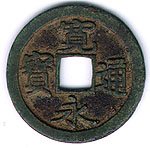 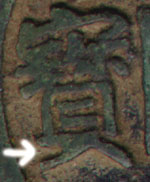 |
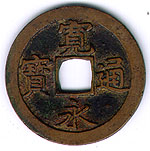 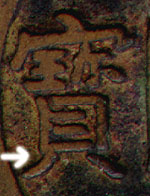 |
|
2. Iron or Copper Alloy All old Kan'ei coins made for circulation are made of copper alloy. New Kan'ei coins are mostly made of copper alloy as well. However, in the early 1700's copper mines began running out in Japan and copper became more scarce. It gradually became more expensive to manufacture copper coins than they were worth. One of the responses to this problem included making coins of iron which was cheaper. The government first authorized the manufacture of iron coins in 1739. Copper alloy coins continued to be manufactured but frequently of less weight and lower quality than those of the late 17th century. Eventually copper alloy coins were mainly minted in higher denominations of 4 mon (from 1768) or 100 mon (from 1835). The best that can be said for the iron coins is that they have a primitive beauty. Iron is difficult to cast with the fine features of coins and script. The surfaces of the coins are rough. The characters are often unclear in appearance and the inner and outer coin edges are often unfiled and jagged. Furthermore, the iron coins rust easily. From 1866, just about the time of the collapse of the feudal order and during a time of civil war and high inflation, iron coins of 4 mon denomination were manufactured. |
|
A copper alloy coin Hirano Shinden, tiger's tail kan (1739) |
A copper alloy coin Naniwa, fine character (1728) |
An iron coin Kamedo, small size (1765) note the old style legs even thugh this is a new Kan'ei coin. This is the single exception to the "legs" rule. |
An iron coin Ishinomaki, small character, haisen (1768) |
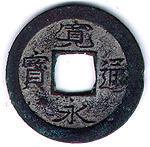 |
 |
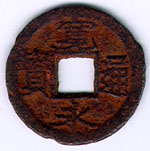 |
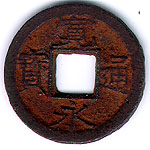 |
|
3. Mintmark and additional characters on back Some new Kan'ei tsuuhou issues have mintmarks on them and many of these are common. Below are some examples of mostly common varieties. Old Kan'ei do not have mintmarks but in rare cases they have numbers and "stars" (dots really) cast on the reverse side of the coin. Below are some common examples of reverse side mintmarks. |
|
Bun Kamedo, shouji mon (1668) 25mm wide x 1mm thick |
Sen Ishinomaki, small character (1768) |
Chou Nagasaki (1767) 22.5mm wide x .9mm thick |
Gen Takatsu, small character (1740) |
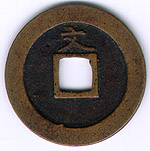 |
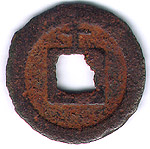 |
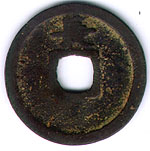 |
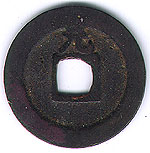 |
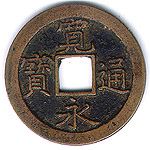 |
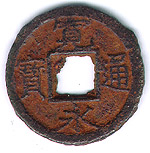 |
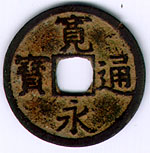 |
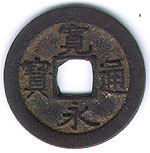 |
|
Kuu Hitachi Ota (1768) |
Kuu ni Hitachi Ota (1774) |
Ashi Ashio, small character (1741) |
Sa (1714 version) Sado (1714) |
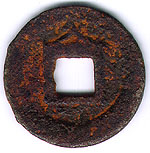 |
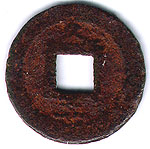 |
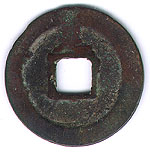 |
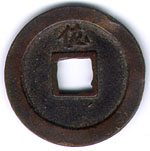 |
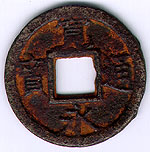 |
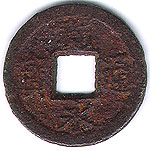 |
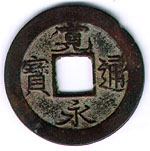 |
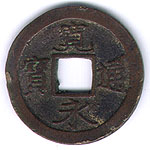 |
|
Sa (1717 version) Sado island (1717) |
Ko Edo Koume (1737)
|
Sen removed Ishinomaki (1776) 22.5mm wide x 1mm thick |
I will later put in below a photograph detail of sen removed taken in angled sunlight |
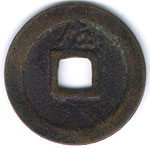 |
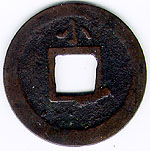 |
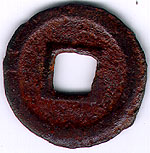 |
|
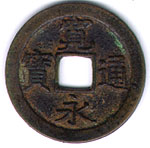 |
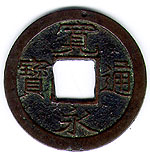 |
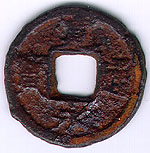 |
|
Sa (1861 iron version) Sado Island the character is difficult to see |
Ichi Ichinose, teikan hai-ichi (1740) This coin image was given me |
|
|
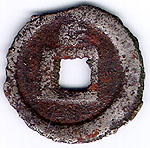 |
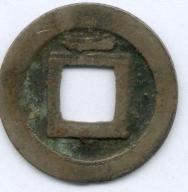 |
||
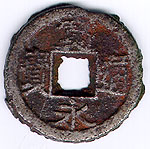 |
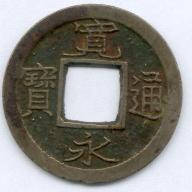 |
|
4. Rim markings A few coins are easily identifiable because special markings were put on the rims at the mint either by casting or by hammering with a die. These range from the moderately uncommon to the rare. The rim markings in copper alloy coins are easy to see while the ones in iron coins usually are difficult to see at first. I do not own many of these but below are a couple of examples. One has a "circle ten" (marujuu) mark and the other a "circle one" (maruichi) mark. Ones with the three parallel lines of the "river" character are also not too uncommon. The placement of the marking is usually at 1:30 if single, or at both 10:30 and 1:30 in a pair as in the examples below. Markings elsewhere on the rim exist but are more rare. |
|
Marujuu (cast version) Edo Juumantsubo (1736) 23mm wide x 1mm thick |
detail of left,this coin has only one rim mark at 1:30 on rim |
Maruichi (cast version) Nagasaki Ichinose (1740) ííçûä€àÍëÂäLõê 23mm wide x 1mm thick |
detail of left. This coin has two rimmarks at 10:30 and 1:30 on the rim. The rim mark on this one was cast into the mother coin. |
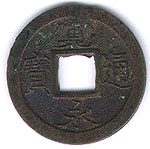 |
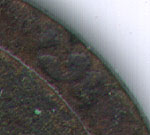 |
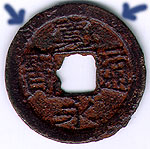 |
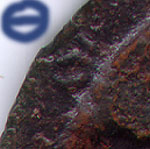 |
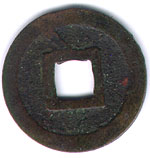 |
There is also a die hammered version of this rim mark (the circulating coin itself was cast as normal) which was produced in 1739. The "marujuu" is half again as large and usually the whole image cannot be seen as it is larger than the rim itself. See below |
There is also a die hammered version of this rim mark, below. the mark is the same size but the "ichi" (horizontal bar) is often tipped in angle to the left or right, whereas the cast ones are always horizontal. The die hammering was done on the mother coin. |
|
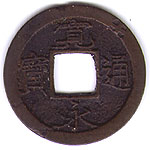 |
This coin to the left is a Marujuu die version, meaning that the juu on the rim was made by hammering with a die into the rim. As a result the orientation is often tilted. | 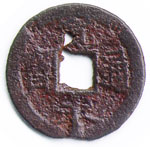 |
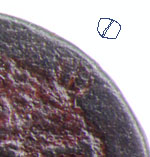 |
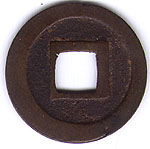 |
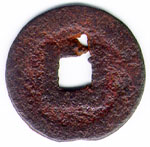 |
This is like the coin above with two marks at 10:30 and 1:30 o'clock, but note that the maruichi is almost vertical. it is an example of the die hammered version. It also has a casting error, leaving a hole. This coin belongs to Bill Dunkle who kindly let me use the image. 23.5 mm x 1 mm
|
|
5. Accidental markings on the mother coin. In the process of manufacturing coins splotches regularly appear. Each such splotch is individual to the coin. Because of very high quality control applied to the mother coins from which circulating coins are made, surviving mother coins almost never have such deformities. If they did then every circualting coin made from that mother coin would have the same deformity. There are rare exceptions, and below is the only one that I own. It is found on a Nikko coin of 1737. It is a strange thing to have happened and I wonder if the survival of the splotches is related to the fact that they happed to appear close to traditional representations of the plover (top left) and the bat (bottom right). Bats were considered good luck. Of course, maybe it was just an accident but somehow I think "superstitious" beliefs of the craftsman may have played a part. |
|
Chidori Nikko chidori (1737) The "chidori" means plover and the top left splotch looks sort of like traditional Japanese drawings of plovers. This chidori is the complete or original version of this coin and the most uncommon variety. The mother coin which caused this deformity was subsequently partially corrected (the splotches partially cut out) and so there is a more common "partial chidori" variety with smaller splotches, and then even a slightly more common "corrected shadow" variety which has the faintest depression where the mother coin's splotches had been cut out but a shade too deeply. |
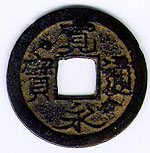 |
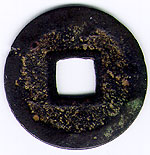 |
|
6. Advanced: Identifying mint by character shape and metal content (not yet. to be on new page) |
last corrected 7/22/03